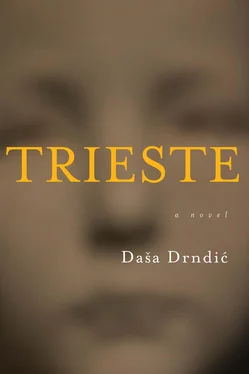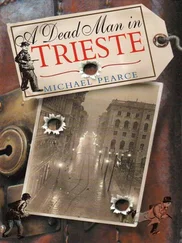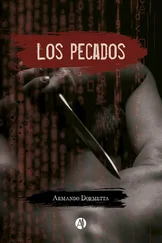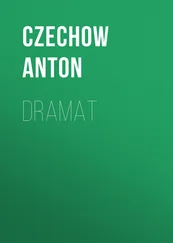Did you see corpses when you got off the train?
Yes.
And?
At first I thought they were the corpses of those who had died on the trip, that they would be bathed and buried. Then Matthes took me into a building at Treblinka 2 and ordered me to begin dragging bodies towards the graves.
In the evening, you again came across the Hauptmann with spectacles?
Yes.
What did he say when he saw you dragging bodies?
He asked why I was dragging bodies. He said, After all, you’re a dentist, you shouldn’t be dragging bodies.
You are a dentist?
No, I am not.
And?
He pulled me by the sleeve, seized me by the hand, dragged me by force, again with blows to the back — I want to stress this — he kept hitting me, and he brought me to a well. Next to the well there were basins with gold teeth and also pairs of forceps for extracting teeth. He said, take the forceps and start extracting teeth from those corpses over there. The corpses were lying by the back exit of the gas chambers.
From where they took them to the graves.
Yes.
And you extracted their teeth?
I did.
You extracted teeth from corpses until the revolt?
Not exactly. I extracted teeth for about a month, a month and a half, until I recognized my sister’s body.
She was lying there, among the dead?
Yes. Then I told the group commander Dr Zimmermann to give me another job. I told him I couldn’t go on with that one.
Who was this Zimmermann?
Dr Zimmermann was the kapo of the dentists.
A Jew?
Yes. I asked him to take me off teeth extraction and put me on cleaning the teeth in the cabin where we lived.
Teeth were being cleaned there?
Teeth were being cleaned there.
How much gold from extracted teeth was sent out of Treblinka each week?
Two suitcases, each weighing between eight and ten kilograms.
Where were the suitcases sent to?
Matthes, one of the camp commanders who also supervised our barracks, said they were dispatched to Berlin.
Did they only contain gold teeth?
Gold teeth and also false teeth removed from bridges. Porcelain teeth.
What did the Germans call the transports of Jews?
They called the bodies die Figuren, as if they were dolls, and the actual transport they called die Scheisse, die Lumpen and other insulting names. It was forbidden to mention victims or corpses or bodies. Everything was secret. When Matthes came down with typhus, he raved in a delirium about the burnings and the gas chambers, so they posted a guard by his bed to silence him if necessary.

Gustav Münzberger, S.S.-Unterscharführer, born on 17 August, 1903. Works as a carpenter, first at his father’s firm, then at a paper factory, and then in the euthanasia centre at Schloss Sonnenstein where he helps in the kitchen as well, so becoming a cook. Was in the S.S. from 1938, in Lublin in 1942, at Treblinka 1942–43 assists Heinrich Matthes in managing gas chambers. Member of team for transporting corpses. In Trieste and Udine in November 1943. Arrested in 1963 at first trial for crimes committed at Treblinka in 1965; sentenced to twelve years in prison. Released for good conduct in 1971. Dies in 1977. His son Horst remembers him as a tender father.
August Miete, S.S.-Unterscharführer. Born in 1908, member of the Nazi Party from 1940. Part of T4 (Grafenek and Hadamar) 1940–42. Treblinka: June 1942-November 1943. Nickname: “Angel of Death”. One of cruellest S.S. men. Shoots without remorse, straight at head, whenever moved to do so. Sentenced in 1945 to life imprisonment. Dies in prison.
Josef Hirtreiter, S.S.-Scharführer, born in 1909. Nickname: “Sepp”. Low I.Q. Held back twice in elementary school; fails locksmiths examination. Finds work as labourer at construction site. Member of Nazi Party from 1932. Hadamer 1940 (washes dishes); Sobibor and Treblinka 1942–43. Speciality: killing one- and two-year-old children: when transports are being unloaded, grabs children by the legs and smashes them against a freight car. The children expire instantly, their skulls crack open. In October 1943 transferred to anti-partisan unit of Trieste police force. Arrested in 1946. Sentenced in 1951 to life imprisonment at the Frankfurt trial. Released in 1977 due to illness and dies six months later in old people’s home in Frankfurt.
August Hengst, S.S.-Unterscharführer, born in 1905 in Bonn. Cook and pastry chef. Member of Nazi Party from 1933. Member of T4 from 1940. Installs kitchen at Brandenburg euthanasia centre and cooks there. Also cooks at Treblinka before 1943, then transferred to Udine, and on to San Sabba, where apart from cooking up swill for camp inmates, he bakes cakes for the commanders. Rainer adores his poppy-seed cakes and strudels. After the war Hengst opens a bakery near Hamburg and local housewives fight over his butter rolls. Closes bakery due to illness and finds work as courier in the port of Hamburg. Likes to wear wide-brimmed hats. Date of death unknown.
Karl Schiffner, S.S.-Unterscharführer, born as Karl Kresadlo in 1901 in Weisskirchlitz, now Novosedlice, the Czech Republic. Trained as carpenter and tradesman. Serves in Czech Army 1921–23. After Czech occupation joins S.A. and later the S.S. troops “because the black uniforms look better”. Works at Sonnenstein euthanasia centre until 1942. In Lublin, Belzec, Sobibor, Treblinka until late 1943, when he is transferred to Trieste to an antipartisan police unit. After the war flees to Carinthia, arrested and held by the British Army at Usbach camp until October 1945. Leaves the camp to go to Salzburg.
Fritz Küttner, S.S.-Oberscharführer, born in 1907. Sentry for many years in German police, supervisor in Camp 1 at Treblinka. Despised by camp inmates. A snooper. Follows and searches inmates, beats them ferociously, then flogs them with a long whip and takes away the smallest piece of personal property they have (family photographs, letters, money), then sends them to infamous Lazarett. Nickname: “Kiwe”. Takes advantage of the helplessness of certain inmates and turns them into informers. Dispatches children to gas chambers without blinking. After Treblinka transferred to Trieste. Dies before trial begins.
Fritz Schmidt, S.S.-Unterscharführer, born in 1906 in Eibau, Germany. Guard and chauffeur in Sonnenstein and Bernburg 1940–41. Chauffeur and head of garage at Treblinka in 1942; looks after equipment for gas chambers. In Trieste in 1943. Arrested by the Allies in Saxony. In December 1949 sentenced to nine years in prison, but escapes to West Germany and no-one cares. Dies in 1982.
Albert Franz Rum, S.S.-Unterscharführer, born in 1890 in Berlin. Nightclub waiter and policeman. Member of Nazi Party from 1933. Stationed at the Berlin T4 headquarters after 1934, works there as photographer. Treblinka 1942–43. When Treblinka is dug up and the camp closed in autumn 1943, Kurt Franz orders him and Willi Mentz to kill the last thirty Jews, which they do, of course. After Treblinka transferred to Trieste as Wirth’s orderly. Sentenced to three years in prison in 1965, but dies before verdict is announced.
Franz Suchomel, S.S.-Unterscharführer (sergeant), born in 1907 in Krumau, today’s Czech Republic. Tailor. From 1940 to 1942 part of the T4 euthanasia programme in Berlin and Hadamar (department of photography). Treblinka 1942–43. Assigned to Treblinka “railway station” where he supervises the processing of women (stripping, gynaecological examinations, shaving of hair) before they are escorted to the gas chambers. Later runs section of “Goldjuden”, in which some twenty inmates — Jews, mostly goldsmiths, watchmakers and bankers — are assigned to collecting and sorting confiscated money and jewellery. In October 1943 sent to Sobibor, then to Trieste. Arrested in 1963 and at first trial for crimes committed at Treblinka in 1965 sentenced to six years in prison. Released in 1969. Dies in 1980 with a relatively clear conscience.
Читать дальше













